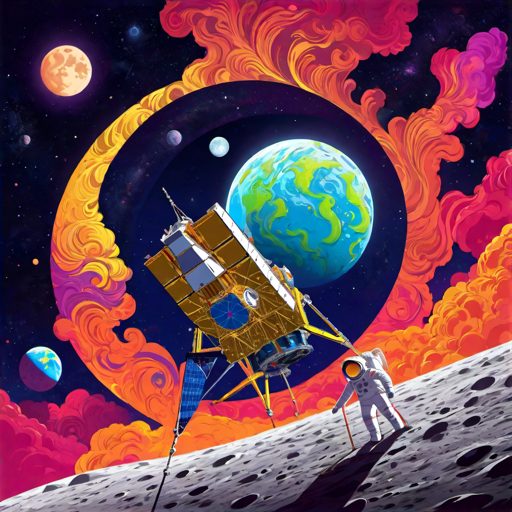
Chandrayaan-3 Shifts from Moon to Earth
Recommended for Chandrayaan-3
The Chandrayaan-3 mission, spearheaded by the Indian Space Research Organisation (ISRO), marks a notable milestone in space exploration and technology. This mission, rich in complexity and ambition, zeroes in on lunar exploration.
Chandrayaan-3 includes important parts such as a Propulsion Module to move the spacecraft, a Lander Module for landing on the Moon, and a Rover for exploring the Moon’s surface.
The central aim was to achieve a soft landing near the Moon’s south polar region. Additionally, the mission planned to conduct various experiments using instruments on the Vikram Lander and Pragyaan Rover.
Ultimately, these efforts aimed to deepen our knowledge of the Moon.
Listen to the news
Mission Design and Components
- Comprehensive Mission Structure: ISRO designed Chandrayaan-3 with three primary components. The Propulsion Module (PM), the Lander Module (LM), and the Rover. Each component plays a specific role in the mission.
- Innovative Propulsion Module (PM): The Propulsion Module acts as the main driver, carrying the Lander Module from the launch vehicle to the orbit around the Moon. Once it finished this main task, the Indian Space Research Organisation reprogrammed the Propulsion Module for extra tasks observing the Earth.
- Advanced Lander and Rover: The Lander Module and Rover come equipped with cutting-edge scientific instruments. They conduct experiments on the Moon’s surface. These experiments focus on the lunar terrain and environment. The Lander Module and Rover achieved a soft landing near the Moon’s south polar region. This landing marks a significant achievement in lunar exploration.
Launch, Landing, and Extended Mission
- Successful Launch and Lunar Touchdown: ISRO launched Chandrayaan-3 on July 14, 2023, witnessing the historic landing of the Vikram Lander on the Moon on August 23, 2023, followed by the deployment of the Pragyaan Rover.
- Extended Scientific Objectives: Initially, the instruments on the Lander and Rover operated for one lunar day. However, the mission’s scope expanded as the Propulsion Module began its unique journey from lunar to Earth orbit.
- Efficient Fuel Management and Orbital Adjustments: The mission’s efficient use of fuel led to surplus reserves in the PM, allowing ISRO to extend the mission’s scope. The team executed precise orbital adjustments for the PM, moving it from the Moon to an Earth orbit for further research opportunities.
Technological Advancements and Space Ethics
- Innovative Orbital Maneuvers and Earth Observation: ISRO skillfully maneuvered the PM from lunar to Earth orbit. This strategic move enabled the continued operation of the SHAPE payload, enhancing Earth observation capabilities.
- Software Development and Maneuver Planning: The mission involved developing new software modules for planning and executing complex maneuvers, showcasing ISRO’s technological prowess.
- Adherence to Space Ethics: A crucial aspect of Chandrayaan-3 was its commitment to avoiding space debris. The mission ensured that the PM did not crash uncontrolled onto the Moon’s surface, setting a standard for responsible space exploration.
Final Thoughts
Chandrayaan-3 exemplifies ISRO’s expertise and ambition in space exploration. Remarkably, the mission met its primary goals of exploring the Moon and achieving a soft landing. Additionally, it creatively repurposed the Propulsion Module for extended Earth observation. This demonstrates the mission’s adaptability and expands its scientific impact.
Furthermore, Chandrayaan-3’s success solidifies ISRO’s foundation for future lunar and interplanetary missions, marking a significant milestone in space exploration and research.
In essence, Chandrayaan-3 has greatly enhanced our understanding of space exploration. It showcases ISRO’s advanced technological skills and innovative mission planning. Importantly, its achievements resonate beyond ISRO, inspiring the global space community to pursue further exploration and discoveries in space.
Similar Stories
- Chandrayaan-3 Shifts from Moon to Earth
- Landing on the Moon: India’s 2040 Vision!
- Close to Lunar Dreams: Chandrayaan-3!
- Chandrayaan-3’s Epic Lunar Odyssey!
- Chandrayaan-3: India’s Moon Adventure Takes Off!
![]()
Curious Times is a leading newspaper and website for kids. We publish daily global news aligned to your learning levels (also as per NEP 2020): Foundational, Preparatory (Primary), Middle and Senior. So, check out the News tab for this. We bring kids’ favourite Curious Times Weekly newspaper every weekend with top news, feature stories and kids’ contributions. Check out daily JokesPoke, Tongue Twisters, Word of the Day and Quote of the Day, kids need it all the time.
ME – My Expressions at Curious Times is your place to get your work published, building your quality digital footprint. And it is a good way to share your talent and skills with your friends, family, school, teachers and the world. Thus, as you will step into higher educational institutes your published content will showcase your strength.
Events, Quizzes and Competitions bring students from over 5,000 schools globally to participate in the 21st-Century themes. Here schools and students win certificates, prizes and recognition through these global events.
Sign-up for your school for FREE!
Communicate with us: WhatsApp, Instagram, Facebook, Youtube, Twitter, and LinkedIn.
0 (Please login to give a Curious Clap to your friend.)
